
The Legend of Zelda: Link's Awakening Review
Remaking a beloved classic like Link’s Awakening is a ‘best of both worlds’ situation. Newcomers get the chance to play one of the most beloved Zelda games in an HD format, whilst returning players can re-experience a game they loved with brand new features and visuals. For that to work, however, Link’s Awakening has to hold up as its own game and not just as a nostalgia trip.
Thankfully, The Legend of Zelda: Link’s Awakening isn’t just a prettier version of the original and instead manages to improve on it in almost every way, creating one of the most memorable games in an already iconic series.
The basic premise to Link's Awakening sees Link stranded on Koholint Island, where he soon learns he has to awaken the mysterious Wind Fish in order to escape. Much of what the game is actually about is left till the last stretch of the adventure, and the twists are definitely something you want to experience without being spoiled.
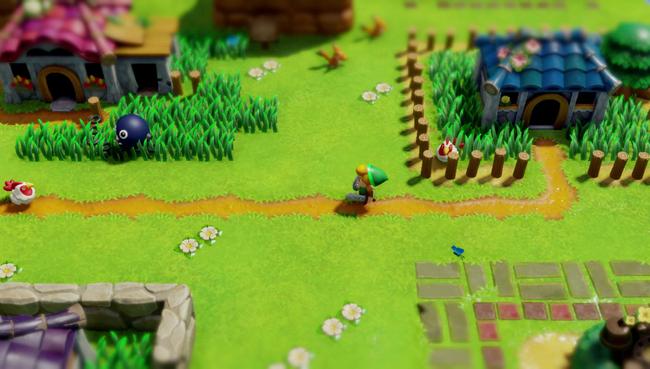
Koholint really is one of the most memorable parts of Link’s Awakening. This new location sets the stage for one of the strangest games in the series; there’s no Triforce, no Zelda or Ganondorf, and you’re going to be running into enough Goombas to make Mario blush. The whole island is very other-worldly, and the appearance of other Nintendo characters in a Zelda game is something that never fails to be fun.
It’s not just about the cameos either. All of the characters are suitably weird, but the highlight of them all is Marin. Although she never quite made the same impact as Zelda, she’s one of the standout story elements of Link’s Awakening. Her relationship with Link is a big driving force for much of the game, and it makes us wish for more formula shake-ups like her.
One of the starkest changes made to the Link’s Awakening remake is the brand new artstyle. Needless to say, it’s absolutely one of the biggest draws to the game, and it wouldn’t be an exaggeration to call it one of the best looking games on the Switch. Everything looks like a little toy-set, and the charm is turned up to 11 with the animations and facial expressions.
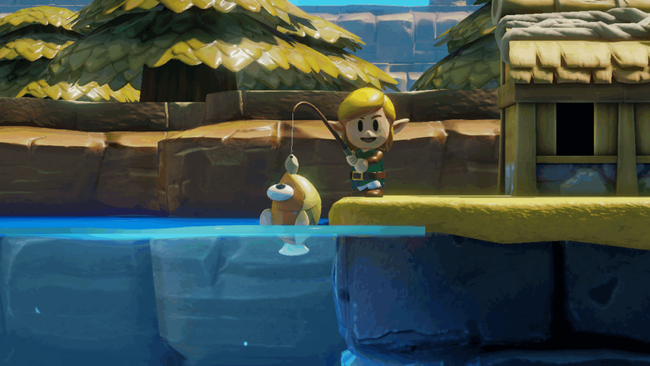
Changing the art-style to something more distinct really captures the charm of Link’s Awakening in a way that the original could only hope to do, and whilst we’d love to see something like it again, it feels like the perfect fit here. It’s this charm that really makes Link’s Awakening as memorable as it is. The way that Link runs with the Pegasus Boots, Mambo’s musical number and even seeing enemies like Anti-Kirby, all just make playing through the game a great time. Zelda as a series has always had its quirks, but this is to a whole new level.
The presentation as a whole is one of Link’s Awakening’s strong suits. Although the reorchestrated music can even be a little repetitive, the sound design in general is done to the typical high Nintendo standard. I especially loved the little sounds that Link makes whenever he does anything, as you’d expect from a Zelda game.
Gameplay remains much the same as it has been in 2D Zelda games since A Link To The Past. Playing as Link, you go across the island of Koholint helping out the inhabitants, clearing dungeons, and working towards the general goal of waking the Wind Fish. Exploration really is key here, with Koholint being split into different areas that all need a new item to get around. The fun comes from peeling back the layers of the island until you’re able to just naturally get around it. One of the things setting Link’s Awakening apart is Link’s ability to jump with Roc’s Feather, which makes navigating the map more fun, as well as introducing some 2D platforming sections in dungeons. It’s a feature that we’d love to see more of in newer Zelda games.
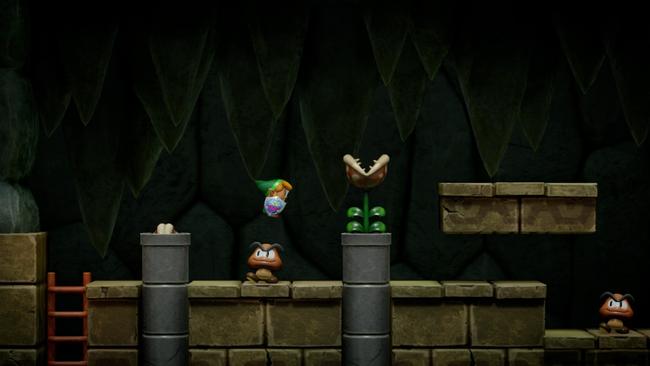
Dungeons play a big role in nearly every Zelda game, and that’s no different here. Each one is fairly intricate but feels natural to explore and figure out. The last two dungeons of the game are a bit of a pain, but besides that, they really are the highlight of the gameplay loop. There’s no greater feeling than finally conquering a dungeon and getting an item that you know you’ve needed to get around.
Although the main quest took me about 15 hours to see through, the exploration isn’t over by any stretch, as there are also a few bits of side-content dotted around. It’s nowhere near as expansive as other titles, but that’s to be expected of what was once a handheld title. Secret seashells and heart-pieces will keep you busy for a while, especially with the number of each going up by a lot. There’s also the optional colour dungeon and a few other mini-games that make for a nice distraction. Neither the Trendy Game or the Rapids held my interest for long but fishing minigame was a welcome distraction.
Thankfully, Link’s Awakening isn’t just a straight redo of the original title with a new style, as it also makes some gameplay changes and adds new content to the mix to make it more enticing for returning players. Combat is one of the areas that has been adjusted, as enemies with shields will now be able to block your attacks, creating a new parrying system that makes fighting a bit more involved. It’s still fairly simple, but even a little tweak like that goes some way to making things more interesting.
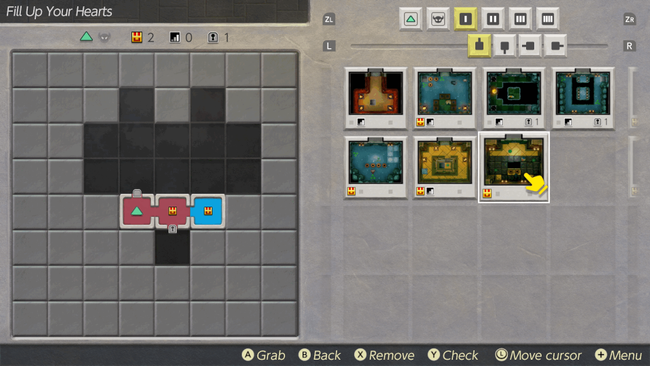
Those who have played the original Link’s Awakening will know that the biggest problem came from inventory management. Because of the limited number of buttons on the Game Boy, players could only have two items equipped at once, even including the sword and shield. It meant that playing through the game was largely sifting through menus, especially with so many different items to use. The update in hardware means that almost all of the key items are mapped to a button, which means that the time spent in the menus is greatly reduced. You’ll still find yourself needing to equip some of the items, but it’s not as much of a headache as it previously was. It would have been cool to have even a few of the other items mapped to the remaining spare buttons, but as it is this improves the game tenfold.
The biggest bit of new content in this re-release is the Dungeon Creator, which lets you put together custom dungeons using rooms from the game. Despite being a promising feature, it’s utilised so poorly that it actually ends up being one of the more annoying aspects of the game.
Almost all of the rooms are simply taken from dungeons in the game, which means that anyone playing through these dungeons already knows exactly what they need to do, and anyone creating them is really just mixing together random bits of the game into a mess. Creators also have to play through the dungeon, which can be pretty time-consuming, especially when you already know what you’re doing. There are far too many restrictions to make any of it fun, even when you’re trying your hardest to make something fun. Even more confusing is the fact that these dungeons aren’t shareable by any other means than amiibo. Unless you and another friend are extremely dedicated, the chances are that you’ll be the only person to even give these dungeons a try. As the only completely new piece of content in the game, it’s a shame that more wasn’t done with it. Zelda Maker this is not.
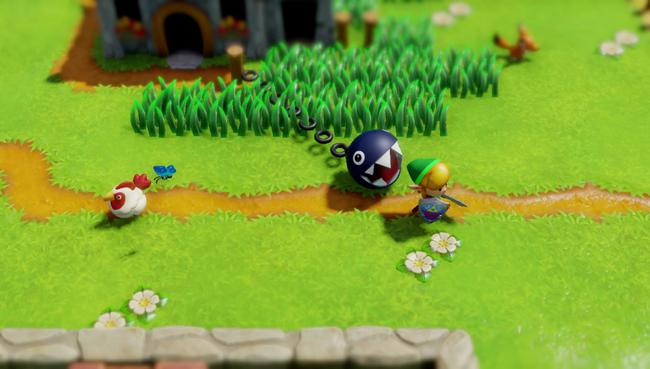
Unfortunately, the Dungeon creator isn’t the only thing holding the Link’s Awakening remake back. The most frustrating problems are technical issues. Stuttering and frame rate hiccups are a constant occurrence throughout the game, especially when moving into a different area of the map or when too much is happening on screen. This happens in both handheld and docked mode. This is especially frustrating considering how fantastically every other aspect of the presentation is handled. By no means does it ruin the game, or even detract from the experience hugely, but it is both distracting and disappointing.
When it comes to looking at remakes and remasters, the one question you really have to ask is, does this improve upon the original game? Thanks to a beautiful presentation, fantastic gameplay that more than holds up today and some significant gameplay tweaks, Link’s Awakening shows that old-school Zelda has just as much of a place in contemporary gaming as it did back in 1993.